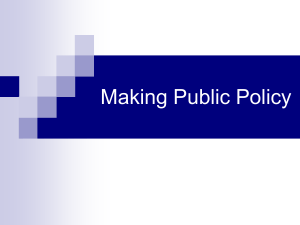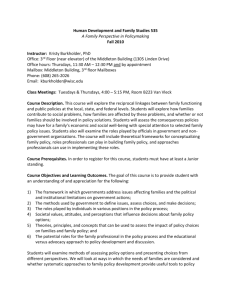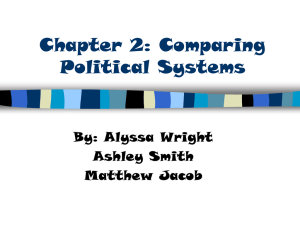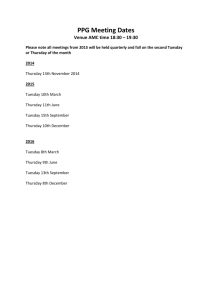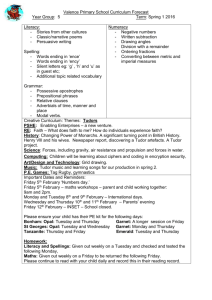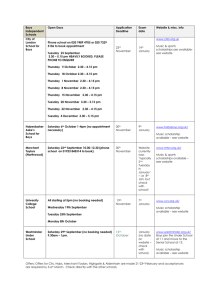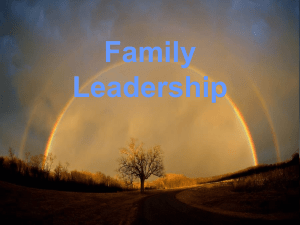A Family Perspective in Policymaking
advertisement
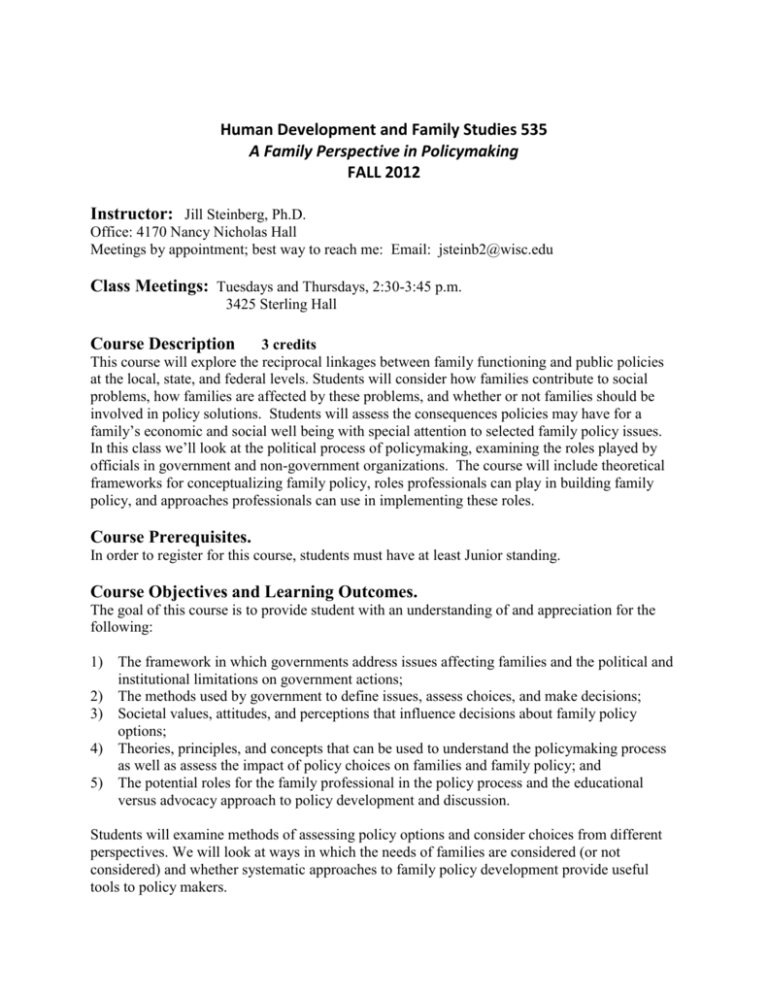
Human Development and Family Studies 535 A Family Perspective in Policymaking FALL 2012 Instructor: Jill Steinberg, Ph.D. Office: 4170 Nancy Nicholas Hall Meetings by appointment; best way to reach me: Email: jsteinb2@wisc.edu Class Meetings: Tuesdays and Thursdays, 2:30-3:45 p.m. 3425 Sterling Hall Course Description 3 credits This course will explore the reciprocal linkages between family functioning and public policies at the local, state, and federal levels. Students will consider how families contribute to social problems, how families are affected by these problems, and whether or not families should be involved in policy solutions. Students will assess the consequences policies may have for a family’s economic and social well being with special attention to selected family policy issues. In this class we’ll look at the political process of policymaking, examining the roles played by officials in government and non-government organizations. The course will include theoretical frameworks for conceptualizing family policy, roles professionals can play in building family policy, and approaches professionals can use in implementing these roles. Course Prerequisites. In order to register for this course, students must have at least Junior standing. Course Objectives and Learning Outcomes. The goal of this course is to provide student with an understanding of and appreciation for the following: 1) The framework in which governments address issues affecting families and the political and institutional limitations on government actions; 2) The methods used by government to define issues, assess choices, and make decisions; 3) Societal values, attitudes, and perceptions that influence decisions about family policy options; 4) Theories, principles, and concepts that can be used to understand the policymaking process as well as assess the impact of policy choices on families and family policy; and 5) The potential roles for the family professional in the policy process and the educational versus advocacy approach to policy development and discussion. Students will examine methods of assessing policy options and consider choices from different perspectives. We will look at ways in which the needs of families are considered (or not considered) and whether systematic approaches to family policy development provide useful tools to policy makers. This course addresses the following Learning Outcomes and Professional Skills: FAMILY STUDIES Learning Outcome D (Knowledge of how families affect and are affected by policies, media, and social institutions) CHILD DEVELOPMENT Learning Outcome F (Ability to consider and evaluate how social policies influence children’s development) Professional Skills A (Thinking Creatively) D (Group facilitation) Required Readings: (1) (Text) Bogenschneider, K. (2006). Family policy matters: How policymaking affects families and what professionals can do. Mahwah, NJ: Lawrence Erlbaum. (2) Ooms, T., & Preister, S. (Eds.) (1998). A strategy for strengthening families: Using family criteria in policymaking and program evaluation. Washington, D.C.: The Family Impact Seminar. Purchased in class – $15 (3) Additional online readings will be posted through our Learn@UW site Equity and Accessibility I recognize that UW students have had diverse life experiences, and some have special needs. I sincerely welcome persons with disabilities in this class, and am happy to do what I can to make the class fair and accessible to you. Please let me know early in the semester if there are any special accommodations (in terms of curriculum, instruction, assessment, etc.) that would help you more fully participate. I will strive to keep information that you choose to share with me confidential. In this class, I strive to maintain a comfortable, respectful environment for all students, regardless of background and political beliefs. From time to time we’ll be discussing issues that you may have strong feelings about. When we do get into these discussions, it is important that we all listen to each other’s perspectives and try to keep our minds open. Course Requirements and Grading: Class attendance and citizenship 15% Most of what happens in this class is NOT lecturing, but a series of structured activities and presentations designed to help you think critically and connect the science of HDFS with public policy. The class is structured much like a study group or policy board that one might encounter in business, education, or the legislature, in which a group of people discuss and grapple with ideas. Each student is a valued citizen of the course and is expected to attend each class, to have read the assigned readings, and to be ready to discuss the ideas and principles addressed in the readings. Good citizenship means acquiring knowledge and sharing knowledge with one another in a respectful and exploratory manner. A student's attendance and good citizenship (i.e., active listening and informed, respectful debate) will be considered in assigning a final grade. Absences due to observance of a religious holiday will not be counted as an absence, as long as you inform me of this during the first two weeks of class. If you find that you have to miss a class for other reasons, please always email me with an explanation. Assignment 1: Who represents you in state and federal government?) (Thursday, Sept 20th) 12.5% Identify the legislators who represent you at the level of state government and also those at the level of the federal government. To do this, first, identify the district in which you are eligible to vote. (If not eligible to vote, use your current residence to determine the district in which you are represented.) At the Federal level, identify the two U.S. SENATORS from your state, and your one REPRESENTATIVE to the U.S. House of Representatives. Then identify the persons who represent you in state government as well, which in most cases will be one state senator (or upper house representative) and one state assembly (lower house) representative. (If Wisconsin is your home state, you can find out who your assembly representative and state senator are at www.legis.state.wi.us. Other states have similar sites.) Using info you find on the web, write a 1 paragraph biographical description for each of these five people, including educational, personal and professional background, party affiliation, and current committee and/or leadership positions held. Thinking beyond the glossy, self-posted info you see on the representative’s web site, speculate about the ways that this person’s particular background and/or life experience might affect their views of family issues and the role of government in regard to families. Try also to identify at least one family-related issue on which this representative has registered a vote during the past year, and tell how that vote might potentially affect families. Assignment 2: Coverage of a family policy issue (Tuesday, Oct 2nd ) 12.5% Pick a single issue that is currently in the news and that has an impact on families. (Some examples might include family planning, marriage laws, childcare regulation, immigration policies, health care law changes, unemployment, etc.) Look at NEWS coverage of this issue in at least 5 different media outlets. Outlets might include local or statewide newspapers or their websites (e.g. WSJ, the Daily Cardinal, the Green Bay Press Gazette, etc), local TV stations or their associated websites (e.g. Channel 3000); national news organizations (e.g. The New York Times, Fox broadcast news or news website, CNN, MSNBC or other national cable news channel, National Public Radio) or internet news services (such as Bloomberg News, Huffington Press, Associated Press, etc). The purpose of this exercise is to compare a VARIETY of sources. Stick to news reporting: be sure to stay away from editorial or opinion pieces or human- interest stories. For each article, first give a complete reference as to where you encountered it: the date aired or published, the title or headline (if there is one), and the complete name of the media outlet. Then, search to find out who actually owns and/or controls the website, news organization or broadcast station. Include this information to the extent that you can find it, noting if you see any reason this ownership structure might lead to bias in reporting the news. (For example, in a highly competitive news market, there may be pressure to make a story seem more urgent or “crisis-ridden” than it is, in order to gain viewer interest.) Summarize what is included in the article, and note if there were facts or perspectives that were not included in this article that you think should have been. In what context are families considered, or even mentioned? What is the tone of the article? (positive, negative, fear-generating, etc.) Were there specific terms, phrases, “code words” or emotional appeals that were used that shape people’s understanding of the issue in a particular way, or served to create fear or stimulate action on the part of the reader? If there is a headline, how might its choice of wording highlight a particular aspect of the story that could influence people’s perception of what is important about the issue? (e.g. Is the article reporting news, or trying to “make news”?) How much confidence do you have in the objectivity of this piece? Finally, after describing each of your articles separately, look critically across all 5 of your sources together. What patterns do you see in terms of bias and complexity of coverage? Why might there be these differences? (For example, what you see on Fox News is likely to be quite different from what you hear on NPR. Why?) Assignment 3: Mid-term take-home exam (Due Oct 23rd ) 15% Specific questions will be assigned one week before this is due, and hard copy be collected in class. Assignment 4: Reports on two policy meetings (Due Nov 1st & Dec 11th. A drop box will be set up in Learn@UW to receive these electronically.) 15% You are to witness the meetings of two different policy-making bodies, at least one of which must be “live, in person” (The other can be viewed on the internet or cable TV if you wish.) Ideally, one of these should be a hearing of the Wisconsin State Legislature at the Capitol, if at all possible. (The legislature will probably not be in session until after the November election, but you can find a calendar of these hearings of the legislature online at http://legis.wisconsin.gov/asmhome.htm if you click on “schedules and calendars”.) Other meetings you may attend include city or county or school board meetings, a judicial proceeding, an advocacy meeting (e.g. Wisconsin Council on Children and Families or the Children’s Trust Fund) or a political forum such as a debate, party caucus or candidate speech, or meeting of the board of a nonprofit organization such as a child care center or religious organization. For each of these two meetings, write a 1-2 page summary that includes the names, dates and locations of both meetings, the number of people in attendance, and a brief summary of what was discussed. For each, consider each of the following (to the extent that it applies): • what perspectives were heard/ voiced in relation to family issues; if you hear any views that fall into one of the three “camps”, you should note this. • which participants were most engaged in the process, or seemed to have the most power • what happened if people disagreed • whether research findings were mentioned or considered as a part of the policy-making process • the general process by which decisions are made by this body • any other insights you gained regarding process of policy-making • the implications for family functions in what you heard said or saw done. See Appendix A (pp 299-303) in the Bogenschneider text for a set of 6 principles you might consider. Family Policy Education Group Activity. (Variously scheduled) 15% Groups of 2-4 students will be assigned to a policy issue that we will be discussing on a specific day in class. This group of students is to present data and other educational material and lead a discussion of policy options, presenting various theoretical perspectives to help us examine the impacts of policy decisions in this area on families. Specific guidelines and framing questions related to each topic will be provided to the group in advance. The group will collaborate to write a briefing paper presenting these findings to me the day you present your information to the class. Final exercise. Due into the Learn@UW drop box on 12/16/12 by 9:45 am. 15% (Details about this exercise will be provided before the last week of class) Evaluation Method and Grading Scale: The number of points accumulated and the application of the following percentages will determine final letter grades: A AB B BC C D F = = = = = = = 93-100 % 87-92 % 81-86% 75-80% 70-74 % 60-69% 0-59 % Guidelines for written work: Students’ written and presented work will be evaluated based on their understanding of course material and concepts, critical thinking skills, completeness, and ability to integrate and apply course material. Written work is due on the designated dates. Extensions may be negotiated, but not guaranteed, as long as you contact me at least 24 hours in advance of the deadline. Other than on the Policy Education Group Activity (which is a collaborative project), all written work in the class is to be original and completed independently. Course Schedule, Guiding questions, Assigned Readings and Due Dates: (Note: This syllabus may be modified during the semester if the need arises) Week 1: No assigned readings the first week of class Tuesday, September 4th Why take a course in family policy? Thursday, September 6th “There ought to be a law!” (or then again, maybe not…) Why is “family policy” so controversial? Week 2: Assigned readings to complete prior to class on 9/11: (Text) Bogenschneider, K. (2006). Do we need a family perspective in policymaking? (Chapter 1) and Bogenschneider, K. (2006). Is policymaking focused more on families or individuals? Are professionals adequately trained in family science, theory, and methodology? (Chapter 2) Tuesday, September 11th Is government policy in the United States focused more on individuals or focused on families? Assigned reading to complete prior to class on 9/13: (Text) Bogenschneider, K. (2006). “What is family policy? What is a family perspective in policymaking?” (Chapter 3). In K. Bogenschneider, Family policy matters: How policymaking affects families and what professionals can do (2nd ed., pp. 29-37). Mahwah, NJ: Erlbaum Thursday, September 13th What is “policy”? What is “family policy”? . Week 3: Assigned reading to complete prior to class on 9/18: (Text) Bogenschneider, K. (2006). “Do families matter, and what is their value in policymaking?” (Chapter 4) and “Are family issues a legitimate focus on policymaking?” (Chapter 5). In K. Bogenschneider, Family policy matters: How policymaking affects families and what professionals can do (2nd ed., pp. 53-64). Mahwah, NJ: Erlbaum. Tuesday, Sept 18th What is the value of families to society? Would policies be more effective if they focused on families? How do families contribute to social problems? Assigned reading to complete prior to class on 9/20: Reading #1 : Zimmerman, S.L. (1995). The institutional framework. Understanding family policy: Theories and applications (pp. 89-103). Thousand Oaks, CA: Sage Publications. Wisconsin Assembly Chief Clerk. (1998). How a bill becomes law. Madison, WI. To retrieve and read this online document, go to: http://legis.wisconsin.gov/assembly/acc/pdf/habbl.pdf Thursday, Sept 20th How are governmental institutions structured? How are laws made? Also due today: Assignment 1 - Legislative biographies Week 4: Assigned Reading to complete prior to class on 9/25 Learn@UW: Zimmerman, S.L., (1995). Rational choice and its variations. Understanding family policy: Theories and applications (pp. 102-141). Thousand Oaks, CA: Sage Publications. If you have not already done so, pick an issue and begin examining how it is covered by the news media (for Assignment 2). Tuesday, Sept 25th What influences policy decisions? Is policymaking a completely rational process? Assigned Reading prior to class on 9/27: (Text) Bogenschneider, K. (2006). How can we bridge the controversy and move family policies forward? (Chapter 9). In K. Bogenschneider, Family policy matters: How policymaking affects families and what professionals can do (2nd ed., pp. 115-139). Mahwah, NJ: Erlbaum. Thursday, Sept 27th 3 alternative views of family change Week 5: Assigned Reading prior to coming to class on 10/2: Learn@UW Coontz, S. (1997). What we really miss about the 1950s. The way we really are: Coming to terms with America’s changing families (pp. 33-50). New York, NY: Basic Books. Assignment 2 due today: media coverage of an issue Tuesday, Oct 2nd Different views of the changing nature of families, the individual and the community. How can we use the theory of paradox to overcome controversy and move family policy forward? Assigned Reading prior to class on 10/4: (Text) Bogenschneider, K. (2006) “A checklist for assessing the impact of policies on families” (Appendix A pp 299-303) and “How to conduct a family impact analysis”. (Appendix B, pp 305-311) Ooms, T.. & Preister, S., (Eds.) (1988). A strategy for strengthening families: Using family criteria in policymaking and program evaluation (pp. 5-29). Washington, D.C.: The Family Impact Seminar. Thursday, Oct 4th A strategy for policy assessment Week 6: Assigned Reading prior to class on 10/9: Rousseau, Jean Jacques. (1762). The social contract or principles of political right: Book I (pp. 1-8). Complete document can also be found at: http://www.constitution.org/jjr/socon_01.htm - 008 King, Martin Luther. (1963). Letter from a Birmingham jail. http://www.africa.upenn.edu/Articles_Gen/Letter_Birmingham.html Learn@UW: Boumediene, Lakhdar (1/7/2012). My Guantanamo Nightmare. The New York Times Sunday Review. Galston, W. A. (11/6/2011) Telling Americans to Vote, or Else. The New York Times Tuesday, Oct 9th Social responsibility and engagement Assigned Reading prior to class on 10/11: (Text) Bogenschneider, K. (2006). What roles can family professionals play to build family policy? (Chapter 12) and Which approach is best for getting involved in family policy: Advocacy or education? (Chapter 13). In K. Bogenschneider, Family policy matters: How policymaking affects families and what professionals can do (2nd ed., pp. 227-243). Mahwah, NJ: Erlbaum Thursday, Oct 11th The role of professionals in policy development The “family policy alternatives education” approach Week 7: Assigned Reading prior to class on 10/16: Fenton Communications (2009) “Now Hear This: The 9 Laws of Successful Advocacy Communications”. Go to http://familyimpactseminars.org/index.asp?p=2&page=skillbuilding&lg=44#44 for a link to this document, or get it from http://www.fenton.com/FENTON_IndustryGuide_NowHearThis.pdf Tuesday, Oct 16th How can I communicate effectively with policymakers? The Family Policy Advocacy Approach Thursday Oct 18th NO CLASS MEETING: Time to work on your midterm exam and organize your group presentations Week 8: Assigned Reading prior to class on 10/23: Peter G. Peterson Foundation. (2008). The state of the union’s finances: A citizen’s guide to the financial condition of the United States government (pp. 1-17). New York, NY. Wisconsin Legislative Fiscal Bureau. (2007). Community aids (financial assistance to counties for human services) (pp. 1-8; 10-13; Appendix I, II, IV and VI). Madison, WI. Tuesday, Oct 23rd Influence of fiscal policy in policymaking and the delivery of services funded by federal and state governments Also: Midterm exam due today . Thursday, Oct 25th (a reading may be assigned) Tuesday, Oct 30th Student group #1: Student group #2: Social security reform Health care reform (Text) Doherty, W.J., & Anderson, J.R. (2006). Can a family-focused approach benefit health care? (Chapter 7). In K. Bogenschneider, Family policy matters: How policymaking affects families and what professionals can do (2nd ed., pp. 85-95). Mahwah, NJ: Erlbaum. Learn@UW : Lentz, S. (2005). Health care cost growth, drivers, and implications for states. Improving health care quality while curbing costs. Wisconsin Family Impact Seminars: Madison, WI. Thursday, Nov 1st Student group #3 Due: first policymaking observation report Learn@UW : Jerald, C. (2009). Aligned by design: How teacher compensation reform can support and reinforce other educational reforms. Washington, D.C.: Center for American Progress. Tuesday, November 6th Student group #4 (a reading may be assigned) Thursday, November 8th School finance and accountability Student group #5 Higher education as a family issue Marriage policies Learn@UW : Ooms, T. (2002). Marriage and government: Strange bedfellows? Washington, D.C., Center for Law and Social Policy. Learn@UW Coontz, S. (11/26/2007) Taking Marriage Private. The New York Times Op-Ed. Learn@UW Sayare & De La Baume (Dec 15, 2010). In France, civil unions gain favor over marriage. The New York Times p. A1 Tuesday, Nov 13th Student group #6 (a reading may be assigned) Defining a balance between work and family Thursday, Nov 15th Can policies be developed to promote good parenting? (Text) Riley, D., & Bogenschneider, K. (2006). Do we know what good parenting is? Can public policy promote it? (Chapter 6). In K. Bogenschneider, Family policy matters: How policymaking affects families and what professionals can do (2nd ed., pp. 67-84). Mahwah, NJ: Erlbaum. (Learn@UW) Kristoff, N.D. (Jan 7, 2012) A poverty solution that starts with a hug. The New York Times. (Learn@UW) Cabrera, N. & Peters, H. E. (2000). Public policies and father involvement. Fatherhood: Research, Interventions and Policies (H. Peters and D. Day Eds.) The Haworth Press, Inc. pp. 295-314. Tuesday, Nov 20th Student group #7 Families and media/technology policies (No class meeting on Nov 22nd – Thanksgiving) Tuesday Nov 27th Student group #8 (a reading may be assigned) Families and the criminal justice system Thursday, Nov 29th Student group #9 (a reading may be assigned) Poverty, welfare and reform Tuesday, Dec 4th Student group # 10 (a reading may be assigned) Families and immigration policies Assigned reading prior to class on 12/6: (Text) Bogenschneider, K., & Corbett, T. (2006). What can we learn from the roots of American social policy about building enduring family policies in the 21st century? (Chapter 10) and “What can we learn from the past about methods for moving family policy forward (Chapter 11). In K. Bogenschneider, Family policy matters: How policymaking affects families and what professionals can do (2nd ed., pp. 141-159). Mahwah, NJ: Erlbaum. Thursday, Dec 6th What’s next: Understanding the past (Your final exercise assignment will be given out today in class) Assigned reading prior to class on 12/11: Learn@UW Bernanke, B.S. (2007). The level of distribution of economic well-being. A speech to the Omaha, NB, Chamber of Commerce. Washington, D.C.: Federal Reserve Board Tuesday, Dec 11th What’s next: Developing an agenda for the future; Second policymaking observation due today . Thursday, December 13th observations Last class meeting: summary and sharing of policymaking Final exercise is due into the Learn@UW drop box by Dec 16th by 9:45 am.
